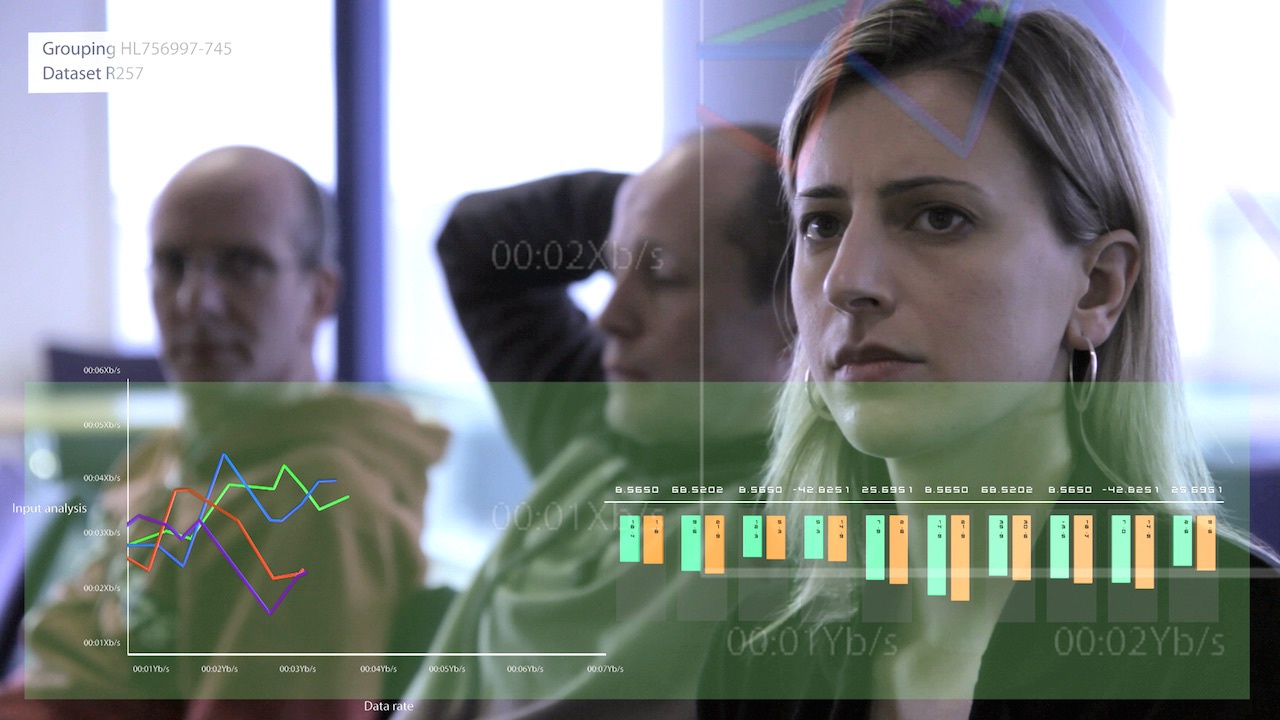Likes and Performance A conversation between Uwe Vormbusch and Steffen Mau on the quantification of the social

Melanie Gilligan, „Popular Unrest“, 2010, Filmstill
Quantification is like the programming code for the operations of evaluation. Without numbers and statistics, there is nothing that can be made out of or used from the attempts by organizations and companies to solicit or encourage evaluation. Figuring out how many likes you have on your Instagram post is one such example – an obvious one at that – but what are the implications for quantification in the realm of art or theater or other cultural domains, where the expectation is that judgment cannot be measured numerically?
These and other related questions are addressed by sociologist Steffen Mau in his penetrating analysis of the quantification of nearly every aspect of one’s life in his recent opus, “Das metrische wir: Über die Quantifizierung des Sozialen” (The Metric We: On the Quantification of the Social, 2017). Together with sociologist Uwe Vormbusch, the two discuss the consequences of quantified life, and offer trenchant statements on the current mode of cultural valuation.
When you write about the allocation of status and its social transmission, you take up this Bourdieuan theme and describe the origination of our numerically determined public biography, for example on Facebook or Instagram, toward which we increasingly orient ourselves and which increasingly defines us. Biography thus becomes socially visible as a sort of channeling of numbers and evaluations from which we can no longer escape, such that we are calibrated to it from the beginning. Calibrated, that is, so that we can appear as particularly good artists, as particularly good scholars, as particularly good friends, with lots of likes, retweets, and so forth.
Here, too, it’s a matter of the relation between the general and the particular, which is indeed a basic character in our reflection on society. You emphasize a specific historical dominance of numbers as the dominance of the general. I’d like to talk about this further, in light of what Foucault has called the “moving base of relations of force,” thus in light of what cannot simply be immobilized through the exercise of power from above and which is now supposed to be managed and controlled, thus “governed,” by means of numbers – or “atomistically,” in Foucault’s words.
Steffen Mau: The basic thesis of my book is that of an ever-increasing quantification of the social, as I call it. As individuals, we are recorded in numerous aspects of our everyday life. Our consumer choices and our spatial movements are charted; our political and social preferences can be registered, just like our networks of friends. This knowledge about us is stored in archives that can be repeatedly used to classify and evaluate us in one way or another, and even, perhaps, to equip us with a certain kind of capital in certain markets. These might be markets of attention, or labor markets, housing markets, partnership markets, in which this data then gives us an either more or less positive status. We can also be selectively targeted by advertising and political campaigns, as we already knew even prior to the scandals around Facebook and Cambridge Analytica.
This is a very general tendency that we are now hardly able to escape. The availability of this data also means that it can be used by many different agents, ranging from state institutions to market agents, as well as what Bourdieu calls “agents of consecration,” that is, agents that sanctify and ennoble certain achievements.

Melanie Gilligan, „Popular Unrest“, 2010, Filmstill
I think we are in agreement regarding the machinery that arises externally, that takes hold of us, that turns us into data, and – what is worse – that leads people to orient themselves to the way in which they become data. The self is thus increasingly understood as capital in relationship markets, reputation markets, and in the future perhaps also as capital in economic transactions, if particular classes of people or bundles of data obtain different prices in the large online warehouses. I think these are very great dangers.
In my opinion, however, numbers also have quite productive characteristics when it’s a question of how people are able to mutually evaluate each other in a fragmented modernity. How can they obtain reliable information about who the other is?
Nonetheless it remains unclear how people deal with numbers, or rather, who deals with which numbers. If it’s a matter of opposition to this economic machinery, this has to be the starting point. It’s necessary to question the cultures of counting, which is to say, the social handling of numbers.
Mau: Yes, the historical framework of the cultures of counting is important. I would nevertheless say that we are now experiencing a qualitative leap with respect to the meaning of numbers. This is one of the things that was unleashed by what we can imprecisely define as neoliberalism, new public management, and new models of governance, which are accompanied by accountabilities to donors, to politics, and to the public sphere.
Indeed, this problem confronts many public institutions. Theaters, for example, must consider which indicators of success to present to funders in order to show that they are a good theater, rather than a mediocre or even a bad one. Reviews in the culture sections of national newspapers – as positive as can be found, of course – then also play a role, as do attendance figures and the relation between development costs and the demand for tickets, but also the impact on social media, the number of followers. These are all indicators with which such institutions can demonstrate that they are performing well. This has very little to do with a narrower evaluation of the artistic performance on the stage. Success can of course be based on very different factors, for example the regional context or the fact that the marketing of one’s artistic accomplishment is particularly successful – these are some of the economies of attention. It can also be the case that over time a sort of reputation-capital will develop, such that the name of the institution sells itself and people go regardless of whether it’s good or not so good.
To give a somewhat more pointed example: In measuring performance in American police forces, officers are evaluated on the basis of, among other things, one central indicator: namely, their per diem arrests. As you can imagine, the number of arrests depends much less on the performance of the individual police officer than on the assigned district and time of day in which he or she serves, and perhaps also on the jurisdiction. It makes a difference whether driving without a license is a civil offense or a felony, which can then lead to different arrest rates.
A study has shown how police officers who are evaluated in this way begin to transfer arrests among one another in order to bolster their standing in terms of reputation as well as performance. They try to get as many arrests as possible, but they also improve their own social position by handing off their “own” arrests to a colleague.
Many widespread performance indicators therefore manifest a certain ambivalence, and perhaps even faultiness, that makes it difficult to represent the actual phenomenon of interest, namely what it means to be a good police officer, or a good theater. Hence they don’t actually measure the real performance that is of interest. The result is a discrepancy between the desired outcome and what is then measured.
Moreover, in this way, established reputation systems, which are more strongly driven by expert opinion, come under pressure from the dominance of numbers, and also from new forms of mass evaluation in which laypeople have the last word. Here I see a reevaluation of previously developed and traditional orders. The problematic consequences of such quantification are however necessarily occluded in the use of indicators when we maintain the illusion that these indicators actually measure what it is we want to know.
For example, with the performance “Fous de danse” by Boris Charmatz at Tempelhofer Feld there was an intense argument over the use of numbers. So-and-so-many thousand Berliners flocked to it. That in itself isn’t very significant, because people can of course go to an event out of curiosity or for voyeuristic reasons. Perhaps they didn’t go to observe the performance succeed, but rather to fail. The attendance figures don’t say very much, even though they’re supposed to be evidence of the success of an event.

Melanie Gilligan, „Popular Unrest“, 2010, Filmstill
This shift in motive, such that for instance theater directors are no longer concerned with staging a “good” play, according to their own standards, but rather one that generates attendance figures, is what Colin Crouch has called “knowledge corruption.” This corruption of existing practices through new techniques of evaluation takes place in many fields, above all in state services such as education and healthcare, which is a big problem. Psychologists speak of “crowding out” when intrinsic motivations and specific convictions as to how I do something well, for example how I stage a performance or a theatrical play or how I teach or raise children, are replaced by an orientation to external data, thus disabling the fundamental logic of the field. This takes us directly to the point of participation and how those who are affected by such mechanisms are not given a hearing when they have to justify their work to various stakeholders, for example, donors. Most people want to do good work and want to make the complexity of this work comprehensible to others, but they’re forced to orient their work to numbering and evaluation, thus to “corrupt” it.
Mau: But of course there’s also an emancipatory character to numbers, too, for example when accomplishments that were previously invisible become visible and thus, through the regime of numbers, there emerges the possibility for certain groups to attain visibility for the first time, to come to appearance and to be incorporated into a system of comparability. This can lead to weakening of the monopoly of expertise, which decides what is good, what is bad, and what is right. However, if we are talking about fields in which a certain kind of expertise is necessary in order to make evaluations at all, that becomes a problem, as for example with the rating of doctors on the internet. Because patients aren’t fully capable of judging medical practice in the narrower sense, they often end up judging secondary criteria: Do I feel comfortable here? Does the doctor have enough time for a conversation? Are there parking spots in front of the office? These ratings are used as if they actually rate the quality of the doctor. They have a very strong navigational function for our attention and for our decision-making. The platform economy thrives on distributing little stars and organizing rankings, thus bringing the world into an imagined hierarchy within which everything can be compared to everything else. What is actually being rated is secondary, whether it’s hotels or cultural institutions. You could interpret this as a kind of uprising of the masses: the unheard now finally have a chance to introduce their voices through what are primarily quantitative ratings. But you could also say that this is a watering-down of slowly developed and highly refined professional standards of evaluation that are more closely bound to the specific logic of a given field, because one can indeed presume that evaluative competence also first has to be developed.
I’ll give another example: after a lecture that I delivered at a foundation, the organizers distributed a questionnaire to all the participants in this public event, asking them to assess me. The quality of my performance was here judged on the basis of 25 separate dimensions. I found that rather impolite. The foundation justified this on the grounds that they receive public funds and are therefore obligated to demonstrate that they spent this money on a high-quality event.
A questionnaire is of course in the first place a simple form of requesting feedback. The expectation that one will express an evaluation of all sorts of things is today constantly laid upon helpful, quality-ensuring customers, users, and visitors, whether they want it or not. There is a universalization of evaluation, thus what I refer to as a cult of evaluation, that causes us to always look at all things with “evaluative eyes.” In the process, however, we lose some of our ability to enjoy things, our open-mindedness. When everything is already “rated” and “ranked,” you only go to a cultural event or to a doctor or a hotel because you want to determine whether the expectation you’ve built up on the basis of this information will be fulfilled or not. Then you make your own evaluation based on the subjective discrepancy between expectation and experience.

L to R: Uwe Vormbusch und Steffen Mau
Another thing that was formulated within this context was a critique of social organizations, a critique of the large associations that had arisen in modernity and then in organized capitalism. These organizations were at first practically indifferent to whatever happened on the outside, because each of them functioned according to its own logic. New instruments for drawing up accounts, such as key metrics and audits, were thus opposed to the ignorance of the big organizations and institutions. They were – alongside the goal of redistribution – an attempt to produce transparency. This transparency is still the effective argument for feedback methods. For indeed the doctors, those demigods in white, and the professors in their musty academic robes, etc., had in a certain way immunized themselves against criticism, too. Ratings and feedback also serve as a critique of the society of organizations that don’t concern themselves with what happens in their environment.
The form that this criticism took is grounded in the social context in which it was introduced. It emerged in the context of large-scale programs such as “Value for Money.” As Margaret Thatcher, in Europe, repeatedly demanded and indeed enforced, public money was henceforth only supposed to be use for precisely specified tasks – and then controlled by means of statistics and evaluations. But the critique that was formulated in this way did not in fact allow organizations to develop in a manner that was suited to their own professional standards, but rather led to resources being minimized or cut altogether. And here we arrive at the aspect of inequality, because, in fact, over decades funding was drained from public services even as performance standards were continuously driven higher.
Mau: The concept of total transparency was a reaction to this: from the “Transparent Man” to the Chinese dictatorship of Big Data, where all possible forms of data are combined into a social credit system that is meant to describe the trustworthiness of a given person in the social context with a point value. This positive evaluation of transparency is something historically new and in fact is opposed to the history of bourgeois society, which is founded on the separation between the public and the private.Previously, expectations of transparency were really only found in the public sphere, not in private. Today, however, these expectations are especially prevalent in the private sphere. This also goes along with forms of digital disenfranchisement, insofar as data is lifted above our reach, in part without us having to give our consent. In my book, I describe this as the “tyranny of light.” The formula is: the more transparency, the better. Criticism of transparency can hardly be formulated. In certain social fields this has more negative than positive effects.
Vormbusch: Absolutely!

Melanie Gilligan, „Popular Unrest“, 2010, Filmstill
Mau: If we are being permanently surveilled, we don’t know who we really might be if we weren’t subject to this surveillance. This is why I ask myself the question of whether it’s possible to discursively reintroduce a more or less already-accomplished demand for transparency. What I see is rather what I call data-voluntarism, in other words the readiness to hand over one’s data and gradually to do without privacy.
Vormbusch: We need to challenge accepted concepts of transparency, because with these methods the question of their production of course doesn’t come up at all. It’s part of a rhetoric of objectivity. I think it’s very important that we have a societal debate over whether and to what extent numbers are objective and serve actual transparency. Or whether numbers instead serve above all to control a given field and to govern it according to the measure of evaluations that have been influenced by particular forms of calculation, which could however always be different. An example of this are the algorithms that Google and Facebook use, which are secret, in contrast to the myth of transparency, and thus can’t be regulated by the public. What we see and how we are incorporated into the network are the results of these invisible controllers, whose labor and decisions are inaccessible to those who are affected by them. On the one side, we have the producers of numbers, the virtuosos of numbers, on the other side the consumers of numbers, who are unable to see, let alone to co-determine, the way in which they are presented within and linked up to the net.
If it’s a matter of critique by way of numbers, the problem is that the criteria with which numbers and calculations operate are not exposed to a public discourse. The mechanisms that would generate perfect transparency with respect to our lives are for their own part secret, and they must become transparent. That is to say: it’s necessary to bring to light the mechanisms through which these numbers are produced. Social critique would then be critique of the numerical worlds that we have created, in order to be able to criticize the exclusions and processes of hierarchization that these numbers have called into being.
On the individual level, the central ideological message of performance evaluation − “we distribute resources solely on the basis of numeric feedback” − has immense consequences. This becomes a problem precisely in societies that, like our society, are characterized by a high degree of insecurity, in which many people are no longer able to pursue a stable career within an organization, but instead remain in insecure situations into their 30s, 40s, or even for their entire lives, in precarious working situations or as (unwilling) freelancers. Here, the allocation of resources on the basis of reputation, status, and metrics becomes especially decisive.
Those who occupy the control rooms of the systems of metrics certainly don’t intend to decouple performance from access to resources, however. This is a point where we have to articulate a critique. This goes for art, or for the so-called art world, too, because this is also a huge problem there, as well as in scholarship.
Mau: The significance of quantification for the art market may be somewhat limited. The criterion of subjectivity is still dominant here − the generation of the particular in the narrower sense, and also a higher level of critical competence. Even if I do see an increasing dissemination of ratings and rankings and ways of evaluating artists, nonetheless visual art remains a sphere that is dependent on experts, in which networks of art critics, galleries, public institutions, and art periodicals are active agents of valorization. They define the value of specific artists and artworks. The intrusion of new forms of evaluation – evaluation by the public, public interest, acclamation in the media, sale prices, followers and likes on social media – certainly factor into this, but nonetheless they still are in competition with the experts. We thus have to deal with two modes of generating attention. One is the mode of popularity and publicity, the other is the mode of expertise, and the two can come into conflict. I can, for example, very well imagine how things that resonate with the public and which count as mass events may be evaluated quite differently by professional art critics.
The market for cultural goods is a very specific market. Recent economic sociology speaks of “fictional expectations.” This refers to the ascription of future evaluations; here, the potential of an artist or an artwork plays just as great a role as does the question of whether and how fictional expectations can be generated. This primarily occurs by means of a story, in the style of an auratic success story that will be realized in the future; thus, in the present-day artistic personality one looks for something that is still quite vague and speculative, but which in the future can determine whether he or she will attain a particular market position and a particular valuation on the market. It’s a matter of the dynamic upward movement of a reputation, a positive vision. As always, telling this story requires the culture of experts, and thus professional critics, art marketers, or art educators and advisors.
If you look at performance art in the narrower sense, what’s interesting is the tension between the transitory aspect of such art events and the traces they are supposed to leave behind. These events therefore have to represent both an attraction at a specific point in time while simultaneously generating an attractiveness that persists beyond this attraction. For something is indeed meant to persist after the event. But the event can never be preserved exactly as it was, as is perhaps the case with other artworks. Here I think there is a kind of symbolic capital that one can derive from a successful performative art project that took place at a specific place at a specific time and which therefore will never again occur in exactly this way. Precisely because it’s fleeting, there’s an image or reputation – possibly an attractiveness that’s increased by being transitory – that nonetheless is transferred to the artist or to the artistic collective or to the institution, and from which future reputation-based profits can be made. With performances, the event-character is in effect, yet there needs to be precisely something that survives beyond the day of the event. I can’t say whether that condenses into numbers or into another form that perpetuates particularity.

Melanie Gilligan, „Popular Unrest“, 2010, Filmstill
Following Andreas Reckwitz, immaterial capitals are tied to the unique, or, less dramatically, to us as individuals. An important question for every society is then how this individuality, this particularity, can again be brought into a relation to the general. And this goes especially for societies that are as highly differentiated as our own, which not only breaks down into individual subsystems, but also into a multiplicity of social milieus in which people are now hardly able to develop a common language in which they can speak rationally about something in common.
Mau: It’s highly debatable whether one can and should actually produce social links and commitments by means of numbers, data, and indicators. First of all, constant comparison unleashes intensified competition, and new hierarchies become established. I would perhaps add something else that seems crucial in the use of numbers. When numbers are used in order to establish orders of visibility or reputation, what we see are extreme effects of concentration with respect to the distribution of attention. In the art market this phenomenon is particularly striking. What we as sociologists designate as a winner-takes-all market is actually a decoupling of attributed success in terms of market returns from actual differences in achievement. This means that at the top there are a few artists who, in principle, can unite a large proportion of the total volume of monetary means that are available in a given market. A very small group of artists makes extreme profits from this market while many others can barely survive, even though it may be the case that the differences between their artistic achievements are not especially large. This naturally also has to do with the quantitative preparation of information, that is to say, with ratings and rankings.
Numbers can create an astounding degree of market transparency, in contrast to reputations based on hearsay. The latter also says which artists are good and which are less good, but it does not consist of the fully accessible, rapidly clickable information that now exists in databanks.
At the moment, what I see is above all people’s great willingness – whether conscious or unconscious – to participate in and to use these recording systems. Furthermore, the market power of technology corporations with respect to the shaping of total information infrastructures that are prepared to encompass our entire lives is becoming greater and greater.
If we don’t agree to the utilization of our data, we are ultimately excluded from a large share of services and consumer opportunities. Thus far I haven’t seen any regulations that would halt this, nor any countermovement that has seriously mobilized against it. It will be difficult to socially articulate existing concerns in a manner that can achieve both breadth and momentum and which doesn’t exhaust itself in the usual criticism of technological madness. It’s something like this: We’re sitting in the digital cage of dependency and we complain about it, but we also keep building it. We seem to be stuck in this double movement of willing participation and critique, without being able to turn the rudder around. The notorious outcries over the misuse of data have so far been largely ineffective.
Vormbusch: We are actually not yet in the historical phase in which humans begin to distance themselves from the mechanisms that they shape, in the sense of a subjectivation qua quantification. Apart, perhaps, from hacker culture and critical initiatives such as “Algorithmwatch,” I likewise still don’t see any relevant countermovement. The everyday as well as the strategic potentials of quantification are too large for that, and their consequences are only too well hidden.
Translation: Daniel Spaulding
